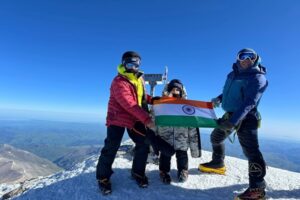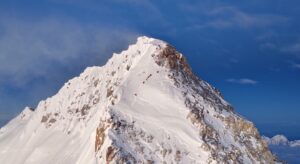The sport of tennis has various flavours of Grand Slam: Players can win a single Grand Slam – one of four major tournaments held in Melbourne, Paris, Wimbledon and New York. That’s pretty easy to understand. But then there’s the Career Grand Slam, the Serena Slam and “The” Grand Slam, the ultimate tennis prize, winning all four majors in the same calendar year.
The interesting thing about these diverse Slams is that there is nothing official about most of them. You score big, of course, for winning New York or Australia, but no trophy comes with bagging some collection of Slams. No governing body created these terms. They’re informal honours bestowed by journalists and fans on certain extraordinary accomplishments.
The tennis situation is worth keeping in mind, because in recent years, the world of adventure has also wrestled with informal Grand Slams. Here, the nuances are murkier: Not only are there no clear definitions, but sometimes adventurers bestow the title on themselves, tweaking the meaning of Grand Slam to fit what they happen to have accomplished.
History of the Explorer’s Grand Slam
The origin of the Explorer’s Grand Slam is not certain but is sometimes attributed to David Hemplemann Adams in 1998, for completing the Seven Summits plus four Poles (North and South, geographic and magnetic).
Full-length treks to the geographic poles, in particular, were so much more difficult than any of the Seven Summits, however, that some advocated for a stronger Grand Slam, which dropped the magnetic pole requirements but added all 14 of the world’s 8,000-metre peaks. Unlike the Seven Summits – which are difficult because of the high altitude but are otherwise mostly snow slogs — the 8,000’ers comprised a world-class tick list worthy to stand alongside grueling full-length treks to the North and South Poles.

David Hemplemann-Adams. Photo: The Telegraph
Only one person, Park Young-Seok of Korea, managed to complete this daunting challenge, in 2005. He climbed the Seven Summits, all 14 8,000’ers and did full-length manhauling expeditions on skis to both Poles. (He later died while attempting a new route on Annapurna.)
This standard proved too difficult for most adventurers. Many wanted to add a flashy title like Grand Slam to their resumés but were unwilling to wrestle with the Arctic Ocean or Antarctica for two months. Gradually, the polar requirements for the Grand Slam were softened to Last-Degree trips. Several companies now guide these week-long, 100km treks from 89º to 90º latitude. They aren’t hard if you’re moderately fit and can afford them. Prices are in the range of $50,000 to $60,000.
Nowadays, the 14 8,000’ers are also typically dropped, so the Grand Slam has come to mean the Seven Summits plus the two Poles. Some even dispute the need to ski last degrees to these geographical extremities. Getting there by plane is enough, they insist, as long as you touch the top and bottom of the world.
Vanessa O’Brien rejects this interpretation. The British-American woman maintains a website called Explorers Grand Slam and has herself done the Seven Summits and Last-Degree polar trips, all within a single year. Her site curates claims and lists those who have completed today’s most common version of the Grand Slam: The Seven Summits and Last Degree to the Poles. “I do reject less than Last Degree trips, which include half-degree, polar marathons and flights direct to the Poles,” she says. “This makes me very unpopular. I completely understand why no one wants to be in the record management business. It’s a thankless job.”

Vanessa O’Brien became the fastest woman to achieve the Explorer’s Grand Slam (Last Degree), taking just 11 months.
Park vs Liang: The “True” Grand Slam Debate
Despite the relaxing standards, earlier this year, a second person completed what is almost an original “True” Grand Slam. Zhang Liang of China climbed the Seven Summits, all 14 8,000’ers and did some version of the Poles. According to reports, Zhang skied 120km to the South Pole in seven days – likely a Last Degree trip. His North Pole claim is more confusing: 600km in 20 days in May 2008.
“Where did he start from?” wonders O’Brien. “It’s 600km from nowhere.” Sometimes, skiers who start from northern Russia get a helicopter ride over the first section, because that is where most of the open water is. This is one way he might have shortened a 765km to 950km full North Pole trek to 600km. ExplorersWeb has reached out to Zhang for clarification but has not received a response.

Zhang Liang. Photo: CGTN
By comparison, Park’s expedition began at the northern tip of Canada’s Ellesmere Island and covered the entire distance to the North Pole in 53 days. His 45-day South Pole expedition was likewise the full 1,130km from Hercules Inlet. But despite being a clear second in style to Park, Ziang’s completion of all the 8,000’ers, as well as the classic Seven Summits, ranks with Andrezej Bargiel’s ski descent of K2 as one of the major adventure accomplishments of 2018.

Ryan Waters en route to the North Pole. Photo: Erik Larsen
O’Brien’s site lists 63 people who have completed the Seven Summits plus a last-degree trip to the North and South Poles. Of these, 17 went further than a last degree at least once. Russian super-traveler Fedor Konyukhov, for example, has skied all the way to the South Pole once – solo — and to the North Pole three times (once solo, once unsupported, once supported). American Ryan Waters has completed the Seven Summits, full treks to both Poles and several supplementary 8,000’ers.
Waters says that he tried to enlist several adventurers to help standardize what a Grand Slam means, but without success. “In the end, we’ve seen that people just say they’ve done the Grand Slam, no matter what style or length,” he says. By now, it is probably too late for alpine clubs and organizations like the Royal Geographical Society and the Explorers Club to add their weight to a single definition.
The general, non-outdoor media tends not to scrutinize adventure claims too closely – these are considered human interest stories rather than something requiring investigative reporting. So in the end, Grand Slams of various flavours and degrees of difficulty all get lumped together into one stew. In tennis, at least, it is clear who has done what, and who hasn’t.






